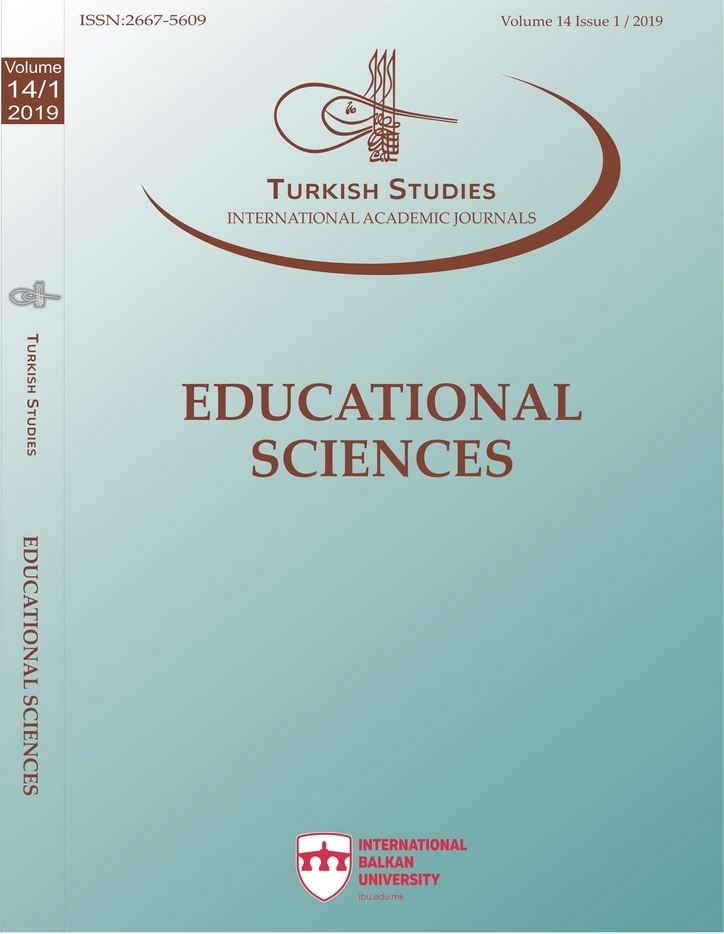İlkokul Ders Kitap Metinlerinde Aile: Bir İçerik Analizi
Family in Primary School Textbooks: A Content Analysis
___
- Balcı, E., & Sel, B. (2017). İlkokul ders kitaplarında yer alan çocuk edebiyatı ürünlerinde toplumsal cinsiyet eşitsizliğine ilişki bir araştırma. Türkiye Sosyal Araştırmalar Dergisi, 723-740.
- Bandura, A. (1971). Social learning theory. General Learning Press.
- Bayrakçı, M. (2007). Sosyal öğrenme kuramı ve eğitimde uygulanması. SAÜ Eğitim Fakültesi Dergisi, 14, 198-210.
- Beavers, R., & Hampson, R. (2000). The beavers systems model of family functioning. Journal of Family Therapy, 22,128-143. https://doi.org/10.1111/1467-6427.00143
- Bee, H., & Boyd, D. (2009). Çocuk Gelişim Psikolojisi. Kaknüs Yayıncılık.
- Bell, L. G., & Bell, D. C. (1982). Family climate and the role of the famele adolescent: Determinants of adolescent functioning. Family Relations, 31(4), 519-527. https://doi.org/10.2307/583927
- Bodner, N., Kuppens, P., Allen, N., Sheeber, L., & Ceulemans, E. (2018). Affective family interactions and their associations with adolescent depression: A dynamic network approach. Development and Psychopathology, 30(4), 1459-1473. https://doi.org/10.1017/S0954579417001699
- Danış, M. Z., & Sülü, C. (2016). Modernleşme sürecinde aile ve sosyal hizmet: güçlendirme yaklaşımı perspektifinden yapısal bir analiz. Tarih Okulu Dergisi. 9(25), 215-230. http://dx.doi.org/10.14225/Joh855
- Demircioğlu, H., Şahin, T. F., & Günindi, Y. (2011). Anne baba görüşlerine göre aile işlevleri. Erzincan Eğitim Fakültesi Dergisi,13(1), 93-105.
- Dreher, M. J., & Singer, H. (1989). Friendly texts and text‐friendly teachers. Theory Into Practice, 28(2), 98-104. https://doi.org/10.1080/00405848909543387
- Duran, E., & Ercan, E. (2018). Fablların değer eğitimindeki önemi. Gelecek Vizyonlar Dergisi, 2(1), 31-43. http://dx.doi.org/10.29345/futvis.15
- Ginther, D. K., & Pollak, R. A. (2000). Does family structure affect children's educational outcomes? FRB Atlanta Working Paper No. 2000- 13a. http://dx.doi.org/10.2139/ssrn.246308
- Gladding, S. T. (2012). Aile Terapisi Tarihi Kuram ve Uygulamaları. Türk Psikolojik Danışma ve Rehberlik Derneği Yayınları.
- Glick, P. (1977). Updating the life cycle of the family. Journal of Marriage and Family, 39(1), 5- 13. https://doi.org/10.2307/351058
- Güneş, Ö. (2008). Ders kitaplarında toplumsal cinsiyet ayırımı. Toplum ve Sosyal Hizmet, 2(19), 81-95.
- Karataş, K. (2001). Toplumsal değişme ve aile. Toplum ve Sosyal Hizmet, 12(2), 89-98.
- Keskin, E. B. (2016). Kentleşme sürecinde ailenin değişimi: Bursa' da bir alan araştırması. Paradoks Ekonomi, Sosyoloji ve Politika Dergisi,11, 158-189.
- Keypour, M., Arman, S., & Reza Maracy, M. (2011). The effectiveness of cognitive behavioral stress management training on mental health, social interaction and family function in adolescents of families with one Human Immunodeficiency Virus (HIV) positive member. Journal of Research in Medical Sciences, 16(6), 741–749.
- Minuchin, S. R. (1978). Psychosomatic families: Anorexia nervosa in context. Harvard University Press.
- Nichols, M. P. (2013). Aile terapisi kavramlar ve yöntemler. Kaknüs Yayınları.
- Okuyan, H. Y., Gül, G. Y., & Karagül, S. (2012). Çocuk edebiyatı yapıtlarında aile kavramı. İlköğretim Online, 395-407.
- Olson, D. (1986). Circumplex model VII: Validation studies and FACES III. Family process. Family Social Science, 25(3), 337-351. https://doi.org/10.1111/j.1545-5300.1986.00337.x
- Onur, B. (2017). Gelişim psikolojisi. İmge Kitabevi.
- Pasley, K., & Petren, R. E. (2016). Family structure. The wiley blackwell encyclopedia of family studies. John Wiley & Sons, Inc. https://doi.org/10.1002/9781119085621.wbefs016
- Ronnau, J., & Poertner, J. (1993). Identification and use of strengths: A family system approach. Children Today, 22(2), 20-23.
- Sharma R. (2013). The family and family structure classification redefined for the current times. Journal of family medicine and primary care, 2(4), 306–310. https://doi.org/10.4103/2249-4863.123774
- Stojiljkovic, J., & Stankovic, M. (2018). Depressive state and social anxiety in adolescents: The role of family ınteractions. American Journal of Family Therapy, 46(3), 244–257. https://doi.org/10.1080/01926187.2018.1506269
- Turnbull, A. P., & Turnbull, H. R. (1990) Families, professionals, and exceptionality. Macmillian Publishing Company.
- Vangelisti, A. L., & Fitzpatrick, M. A. (1995). Explaining family ınteractions. SAGE Publications Inc.
- Voydanoff, P., Fine, M.A. & Donnelly, B.W. (1994). Family structure, family organization, and quality of family life. J Fam Econ, 15, 175–200. https://doi.org/10.1007/BF02353627
- Walsh, F. (2012). Normal family processes: Growing diversity and complexity. Guilford Publications.
- Walsh, F. (2017). Aile normalliği, sağlığı ve işlevsizliğine dair klinik görüşler. normal aile süreçleri. Pegem Akademi.
- Yapıcı, M. (2004). İlköğretim1 kademe ders kitaplarının öğrenci düzeyine uygunluğu. Sosyal Bilimler Dergisi, 6(1) 122-130.
- Yavuzer, H. (1999). Ana-baba ve çocuk. Remzi Kitabevi.
- Yaylı, D., & Çınar, E. K. (2014). Ortaokul Türkçe ders kitap görsellerinde toplumsal cinsiyet. Turkish Studies, 9(5), 2075-2096. http://dx.doi.org/10.7827/TurkishStudies.6870
- ISSN: 2667-5609
- Yayın Aralığı: Yılda 6 Sayı
- Başlangıç: 2006
- Yayıncı: ASOS Eğitim Bilişim Danışmanlık Otomasyon Yayıncılık Reklam Sanayi ve Ticaret LTD ŞTİ
Öğretmenlerin Örgütsel İkiyüzlülük Algıları ve Bazı Değişkenlere Göre İncelenmesi
Esra KAYIŞ, Necati CEMALOĞLU, Esra SİPAHİ
Eğitimde Ölçme ve Değerlendirme Dersine Yönelik Tutum Ölçeğinin Geliştirilmesi
Betül POLAT DEMİR, Esra EMİNOĞLU ÖZMERCAN
Öğrencilerin Yeşil Kimya ve Sürdürülebilir Kalkınmaya Yönelik Algılarının Belirlenmesi
Zafer KARAGÖLGE, Fatma SARI, ALİ KOLOMUÇ, İlhami CEYHUN
Öğretmen Adaylarının Gözüyle Birleştirilmiş Sınıflarda Öğretmen Olmak: Bir Olgu bilim Çalışması
Öğrenciliğe Dönük Tutumun Cinsiyet, Başarı, Çalışma Ortamı ve Sınıf Düzeyleri Açısından İncelenmesi
Gamze Yeşim GÖKTÜRK, M. Yüksel ERDOĞDU
Zekâ Oyunlarına Yönelik Tutum Ölçeğinin (ZOTÖ) Geliştirilmesi: Geçerlik ve Güvenirlik Çalışması
Abdulhamit KURUPINAR, Yasemin AYDOĞAN
Pre-Service Teachers’ Perceptions on Distance Education
SEDAT ALTINTAŞ, Güler GÖÇEN KABARAN, Salih UŞUN
Tarih Öğretmenlerinin Okul Dışı Öğrenme Ortamlarına Yönelik Görüşlerinin İncelenmesi
